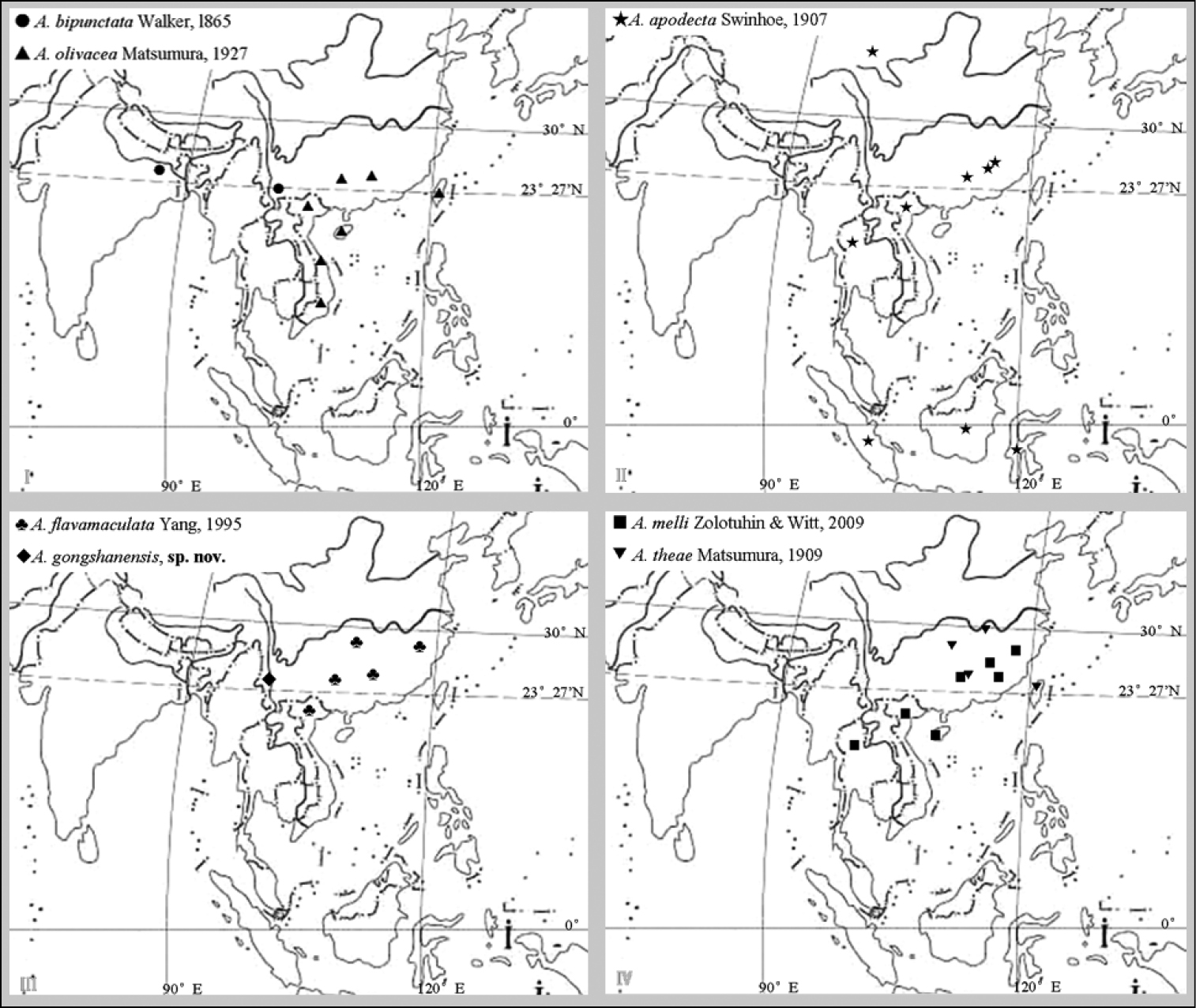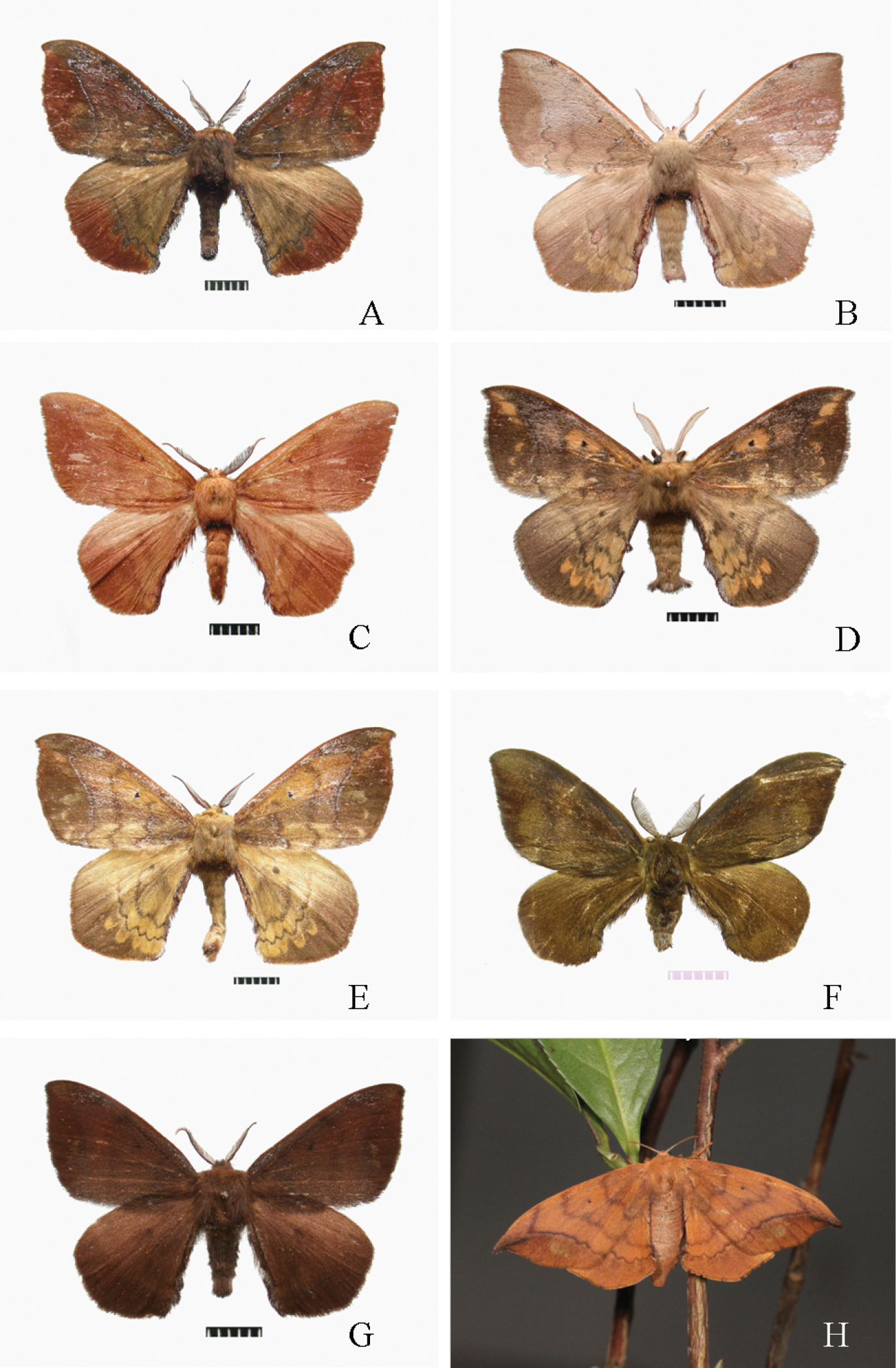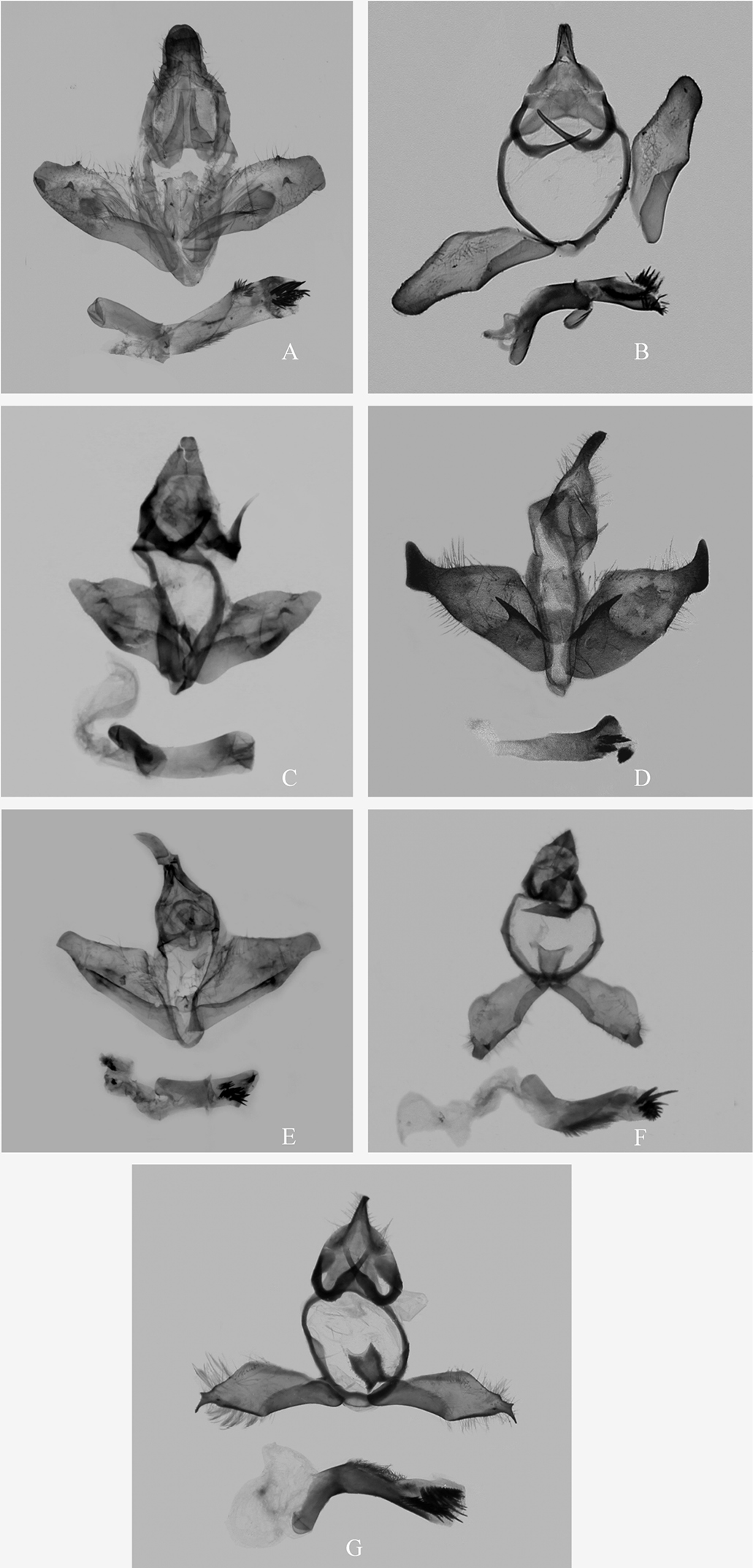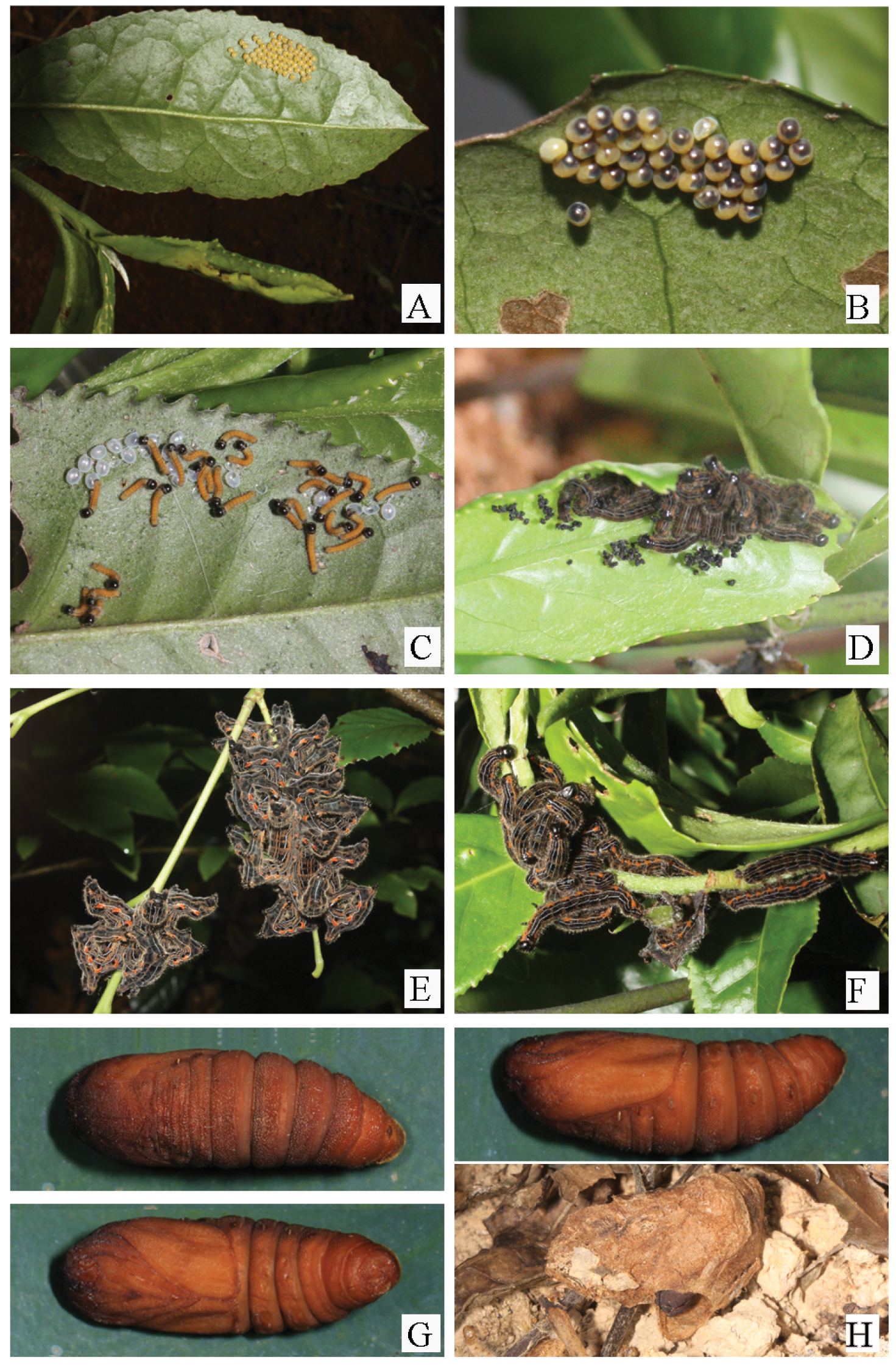






(C) 2011 Xing Wang. This is an open access article distributed under the terms of the Creative Commons Attribution License, which permits unrestricted use, distribution, and reproduction in any medium, provided the original author and source are credited.
For reference, use of the paginated PDF or printed version of this article is recommended.
The six species of the genus Andraca Walker hitherto known from China are reviewed, and a new species, Andraca gongshanensis, sp. n., described from Yunnan Province, China. Adults and male genitalia of all examined species are illustrated, together with a distributional map. A key to all seven Chinese Andraca species is provided. The types of the new species are deposited in SCAU (South China Agricultural University, Guangzhou, China) and HUNAU (Hunan Agricultural University, Changsha, China).
Taxonomy, Lepidoptera, Endromidae, Andraca , new species, China
The genus Andraca was established by Walker (1865) with Andraca bipunctata Walker 1865 as its type-species, a species well known as one of the most serious pests of tea plants (Chu and Wang 1996). It was placed in family Bombycidae for over 150 years, but was recently transferred to family Endromidae based on the molecular study of Zwick et al. (2011). Kishida (1993) reported Andraca theae and Andraca olivacea from Taiwan. Chu and Wang (1993) recorded three Andraca species from China: Andraca bipunctata is widely distributed in central and southern China, Andraca henosa Chu & Wang, 1993 was listed from Yunnan, and Andraca hedra Chu & Wang, 1993 from Hainan and Fujian; in this paper, they also included Andraca gracilis Butler 1885, which is currently placed in the genus Pseudandraca Miyata, 1970. Yang (1995) added one species, Andraca flavamaculata Yang, 1995, to the Chinese Andraca fauna. Owada et al. (2002) reviewed three species of Andraca from Vietnam and provided a world checklist. Zolotuhin and Witt (2009) recorded five Andraca species from Vietnam, describing two new species, Andraca stueningi Zolotuhin & Witt, 2009 and Andraca melli Zolotuhin & Witt, 2009, and newly treating two taxa, Andraca trilochoides roepkei Bryk, 1944 and Andraca olivacea olivacens Mell, 1958, as subspecies of Andraca trilochoides Moore, 1865 and Andraca olivacea Matsumura, 1927 respectively. At present, the genus Andraca consists of eight species ranging from the Himalayas to Southeast Asia.
In the present paper, seven Chinese Andraca species are reviewed, including the description of one new species Andraca gongshanensis, sp. n. The early stages of Andraca theae (Matsumura 1909) are described in detail. A key to the seven Chinese Andraca species is provided.
Materials and methodsSpecimens of the new species were collected by light trap. The types of previously described species in the Natural History Museum, London, UK (BMNH) were examined. Other materials examined in this study are preserved in SCAU and HUNAU. Morphological terminology used in descriptions follows Lemaire and Minet (1999).
Taxonomyhttp://species-id.net/wiki/Andraca
Forewing weakly falcate. Ground color varying from shades of brown to sandy grey.
Male genitalia. Uncus apically single-pointed to weakly indented; gnathos with two long, basally broad, upcurved arms; valvae basally broad, sclerotized, long or medium length; aedeagus short with apex truncated, cornuti present or absent.
Female genitalia (Andraca bipunctata). Eighth segment curved deeply, ventral margin of ostium bursae extends posteriorly as a broad bilobed plate, ductus bursae sclerotized distal to mid-point, tapering to half width; distal half unsclerotized with slight torsion, corpus bursae lacking a signum.
Oriental Region, S & E Palaearctic.
Andraca species have sometimes been described in Mustilia (e.g., Chu and Wang 1993, 1996), and misidentification has also been frequent (Chu and Wang 1993, 1996). Andraca was considered to belong to ‘the Mustilia lineage’ of Prismostictinae Forbes, 1955 (Holloway 1987; Minet 1994; Lemaire and Minet 1999; Holloway et al. 2001). Our own unpublished work also shows that Andraca is close to Mustilia Walker, 1865 and Mustilizans Yang, 1995, based on phylogenetic analysis of mitochondrial and nuclear DNA sequences (COI + 18S +28S) (Wang 2010).
Sevastopulo (1938) described the fully grown larvae of the type species. The larvae are gregarious, have short hairs covering the body, and are often heavily parasitized. Pupation is in a thin cocoon of brown silk spun among leaves.
| 1 | Apex of forewing falcate | 2 |
| – | Apex of forewing not falcate | 5 |
| 2 | Uncus broad, gnathos extremely swollen medially | Andraca bipunctata |
| – | Uncus narrow, gnathos not swollen | 3 |
| 3 | Apex of valva boot-shaped | Andraca flavamaculata comb. rev. |
| – | Apex of valva rounded or truncate | 4 |
| 4 | Apex of valva rounded, gnathos long | Andraca olivacea |
| – | Apex of valva truncate, gnathos short | Andraca gongshanensis sp. n. |
| 5 | Apex of valva bifurcate | Andraca theae |
| – | Apex of valva rounded | 6 |
| 6 | Gnathos not swollen | Andraca apodecta |
| – | Gnathos extremely medially swollen | Andraca melli |
| 1 | Apex of forewing falcate | 2 |
| – | Apex of forewing not falcate | 5 |
| 2 | Uncus broad, gnathos extremely swollen medially | Andraca bipunctata |
| – | Uncus narrow, gnathos not swollen | 3 |
| 3 | Apex of valva boot-shaped | Andraca flavamaculata comb. rev. |
| – | Apex of valva rounded or truncate | 4 |
| 4 | Apex of valva rounded, gnathos long | Andraca olivacea |
| – | Apex of valva truncate, gnathos short | Andraca gongshanensis sp. n. |
| 5 | Apex of valva bifurcate | Andraca theae |
| – | Apex of valva rounded | 6 |
| 6 | Gnathos not swollen | Andraca apodecta |
| – | Gnathos extremely medially swollen | Andraca melli |
http://species-id.net/wiki/Andraca_bipunctata
Figs 1–A, 2–AMale (China): wingspan 42–45 mm, length of forewing 21–23 mm, antenna length 6–8 mm (Fig. 1-A). Male genitalia (Fig. 2-A): uncus broad, duck beak-shaped; gnathos long, finger-shaped; vesica with a cluster of strong spinose cornuti
Female genitalia: see above under generic entry.
[CHINA]2♂♂, western Yunnan, 2005-VI-15, Ming-Yi Tian leg.; 2♂♂, Dulongjiang, Yunnan Province, 2006-VII-21, Min Wang & Xiao-Ling Fan leg.; 1♂1♀, Gongshan Mountain, Yunnan Province, 2006-VII-22 , Min Wang & Xiao-Ling Fan leg.
China (Yunnan); India.
Distributional map of Andraca spp. from China.
Distributional map of Andraca spp. from China.
This widely distributed species is rather variable in coloration and size. Moore (1865) described Andraca trilochoides from a brighter and grayish individual. This taxon was later synonymized with Andraca bipunctata by Hampson, ([1893]), an action that was followed by Strand (1924).
Andraca bipunctata is closely related to Andraca angulata Kishida, 1993 (Nepal and India: Sikkim), Andraca theae (Taiwan) and Andraca stueningi (Vietnam). These four species form the bipunctata group, and share the following characteristics: 1) male hindtibia with one pair of spurs; 2) two dorsally-directed projections present on subapical part of valva; 3) external surface of aedeagus partially covered with hair-like spines; 4) a cluster of strong spinose cornuti on vesica.
Larvae of Andraca bipunctata are well-known serious pests of tea trees, Camellia sinensis (Theaceae) (Banerjee 1982; Chang 1989; Chen et al. 1992; Panigrahi 1995; Ho et al. 1996; Upadhyay et al. 2001).
Adult male Andraca spp. A Andraca bipunctata Walker, l865 from Yunnan B Andraca olivacea Matsumura, 1927 from Guangdong C Andraca apodecta Swinhoe, 1907 from Guangxi D Andraca flavamaculata Yang, 1995 from Guangdong E Andraca gongshanensis, sp. n., Holotype, from Yunnan F Andraca melli Zolotuhin & Witt, 2009 from Guangdong G Andraca theae Matsumura, 1909 from Hunan Province H Andraca theae Matsumura, 1909 from Hunan Province (in field).
Adult male Andraca spp. A Andraca bipunctata Walker, l865 from Yunnan B Andraca olivacea Matsumura, 1927 from Guangdong C Andraca apodecta Swinhoe, 1907 from Guangxi D Andraca flavamaculata Yang, 1995 from Guangdong E Andraca gongshanensis, sp. n., Holotype, from Yunnan F Andraca melli Zolotuhin & Witt, 2009 from Guangdong G Andraca theae Matsumura, 1909 from Hunan Province H Andraca theae Matsumura, 1909 from Hunan Province (in field).
http://species-id.net/wiki/Andraca_olivacea
Figs 1–B, 2–BMale: wingspan 36–38 mm, length of forewing 16–20 mm, antenna length 5–7 mm (Fig. 1-B). Hindtibia with two pairs of spurs; hindwings with Rs and M1 connate. Male genitalia (Fig. 2-B): uncus thick and round; valva simple, basal half broad and terminal half narrow; distal margin of aedeagus with strong lateral spines; vesica with a cluster of spinose cornuti.
[CHINA] 1 ♂, Shimentai Provincial Nature Reserve, Yingde City, Guangdong Province, 2001-VII-24, Min Wang & Guo-Hua Huang leg.; 1 ♂, same data but 2001-IX-22; 3 ♂ ♂, same data but 2002-VI-11, Guo-Hua Huang leg.; 1 ♂, Nanling National Nature Reserve, Ruyuan City, Guangdong Province, 2002-VII-23, Guo-Hua Huang leg.; 4 ♂ ♂, same data but 2003-III-29~31; 1 ♂, same data but 2003-VI-22; 2 ♂ ♂, same data but 2003-VIII-7; 2 ♂ ♂, same data but 2003-VIII-18; 5 ♂ ♂, same data but 2004-IV-23; 1 ♀, same data but 2004-IV-24; 2 ♂ ♂, same data but 2006-IX-18, Liu-Sheng Chen leg.; 1 ♂, same data but 2008-VI-7, Min Wang leg.; 1 ♂, same data but 2008-VI-7; 1 ♂, same data but 2009-IV-1, Hou-Shuai Wang leg.; 1 ♂ , same data but 2009-VIII-10; 1 ♂, same data but 2009-IV-1; 1 ♂ , same data but 2009-VIII-10; 1 ♂, Maoershan National Nature Reserve, Xingan City, Guangxi Province, 2003-III-3, Min Wang & Guo-Hua Huang leg.; 6 ♂ ♂, Jianfengling National Nature Reserve, Ledong City, Hainan Province, 2003-XI-29~31, Guo-Hua Huang & Min Wang leg.; 1 ♂, same data but 2007-X-23, Min Wang leg.
China (Taiwan, Guangdong, Guangxi, Hainan); Vietnam.
Wang (1995) provide a fine color illustration of a fresh living male. Owada et al. (2002) considered Andraca olivacens from Fukien (= Fujian) to the synonym of Andraca olivacea, whereas Zolotuhin and Witt (2009) treated it as a subspecies thereof. We do not comment further on which of these two alternatives may be the most appropriate status for this taxon because we have not seen the types of Andraca olivacens.
Male: wingspan 37–39 mm, length of forewing 15–18 mm, antenna length 6–8 mm (Fig. 1-C). Head covered with reddish-brown hairs; forewing with black discal spot, smooth outer margin and apically not falcate. Male genitalia (Fig. 2-C): uncus triangular, apical half truncate; valva with two subapical, dorsally-directed projections; aedeagus short, curved slightly without cornuti, external surface without hair-like spines.
[CHINA]2♂♂, Jinzhongshan Mountain, Longlin City, Guangxi Province, 2007-VII-31, Liu-Sheng Chen leg..
Unknown.
China (Guangxi, Yunnan, Fujian, Shaanxi), Vietnam, Thailand (Chiang Mai, Nan), Indonesia (Sumatra, Borneo, Sulawesi).
The species was first recorded from China (Yunnan, Fujian, Shaanxi) by Zolotuhin and Witt (2009) and is here recorded from Guangxi for the first time.
http://species-id.net/wiki/Andraca_flavamaculata
Figs 1–D, 2–DMale: wingspan 40–44 mm, length of forewing 20–22 mm, antenna length 6–7 mm (Fig. 1-D). Body stout. Forewing apex falcate; outer edge smooth and straight; tornus almost rectangular. Male genitalia (Fig. 2-D): uncus long with apex finger-shaped; tegumen broad with numerous long setae; valvae basally broad, strongly sclerotized, apex of valva boot-shaped; sacculus broad, with a strong dorsal spike; saccus short and narrow; aedeagus short but strong and straight, distally with a large number of spines.
[CHINA] 2 ♂♂, Nanling National Nature Reserve, Ruyuan City, Guangdong Province, 2002-III-15, Guo-Hua Huang leg.; 2 ♂♂, same data but 2003-II-23; 5 ♂ ♂, same data but 2003-III-29 ~ 31; 1 ♂, same data but 2003 -VIII-30; 1 ♂, same data but 2006-IX-17, Zhen Li leg.; 2 ♂♂ , Maoershan National Nature Reserve, Xingan City, Guangxi Province, 2003-III-03, Min Wang & Guo-Hua Huang leg.; 3 ♂ ♂, Mangshan Nature Reserve, Yizhang City, Hunan Province, 2003-III-31, Guo-Hua Huang leg.; 1 ♂, Jiuwandashan National Nature Reserve, Guangxi Province, 2003-VII-30, Guo-Hua Huang leg.
Unknown.
China (Zhejiang, Hunan, Guangdong, Guangxi); Vietnam.
Yang (1995) described the species from Zhejiang, China. The species is similarto Andraca olivacea but can be distinguished by the following characters: aedeagus straight; gnathos not prominent. Zolotuhin and Witt (2009) synonymized Andraca nabesan Kishida & Owada, 2002 with Andraca flavamaculata, which they also transferred to Pseudandraca species based on features of the genitalia. We accept the synonymy but do not agree with the generic transfer, because we do not consider that the diagnostic feature of Pseudandraca given by Miyata (1970), a valva with a “long distinct projection” is present in Andraca flavamaculata. We therefore transfer Andraca flavamaculata comb. rev. back to Andraca.
urn:lsid:zoobank.org:act:E5DD5FB7-554B-48A6-9EF3-65F1699E9897
http://species-id.net/wiki/Andraca_gongshanensis
Figs 1–E, 2–EMale: wingspan 46–48 mm, length of forewing 22–24 mm, antenna length 5–8 mm (Fig. 1-E). Antenna bipectinate except apex. Wings ground color dark brow with dark brow fasciae and reddish-yellow patterns, which is consisting of antemedian, discocellar, postmedian fascia, and reddish-yellow patterns nearly placed on the wholly wings but termen. Forewing apex falcate; outer edge smooth and straight; tornus almost rectangular. Hindwing with anal margin straight; outer margin angled at vein M3, straight above and below this.
Male genitalia (Fig. 2-E): uncus long with wedge-shaped apex; tegumen broad; gnathos very well developed, arms upcurved; valvae basally broad with many long setae, strongly sclerotized, caudally constricted to a spatulate apex; sacculus broad, without a dorsal spike; aedeagus short but strong and straight, distally with a large number of spines.
♂, Gongshan Mountain, Yunnan Province, China, 2006-VII-22, Min Wang & Xiao-Ling Fan leg., deposited in Department of Entomology, SCAU; Paratypes, 2 ♂♂, same data as holotype but 2006-VII-21.; 1 ♂, same data as holotype but 2006-VII-23; deposited in Institute of Entomology, HUNAU.
Unknown.
China (Yunnan).
The specific epithet refers to the type locality(Gongshan Mountain, China).
This new species is very similar to Andraca flavamaculata, but can be distinguished by the following characters of the male genitalia: Andraca gongshanensis, sp. n. with uncus apex wedge-shaped, apex of valva constricted and truncate, sacculus without a strong dorsal spike. And Andraca flavamaculata with uncus apex finger-shaped, apex of valva boot-shaped; sacculus broad, with a strong dorsal spike.
Externally, Andraca gongshanensis is paler than Andraca flavamaculata.
Male: wingspan 37–39 mm, length of forewing 15–18 mm, antenna length 5–7 mm (Fig. 1-F). Antenna bipectinate except apex. Head thinly covered with brown-green hairs. Forewing: apically bluntly pointed; outer edge smooth and straight, tornus nearly rectangular. Hindwings distinctly angled at vein M3, straight above and below this.
Male genitalia (Fig. 2-F): uncus bluntly triangular with long hairs; tegumen broad; gnathos with two extremely medially swollen arms; valvae flattened, strongly sclerotized, apex narrower and truncate with a dorsally directed projection from the middle; saccus short and broad; aedeagus short, strongly curved, with a compact group of long, thick needle-shaped cornuti on dorsal surface.
[CHINA]2 ♂♂, Nanling National Nature Reserve, Ruyuan City, Guangdong Province, 2007-VI-23, Liu-Sheng Chen collected larvae and reared to adult.
Camellia sinensis (Theaceae), Camellia oleifera (Theaceae), Fraxinus pennsylvanica (Oleaceae) and Ternstroemia japonica (Ternstroemiaceae), Pentaphylax euryoides Gardn. & Champ. (Pentaphylacaceae) (new host record).
China (Zhejiang, Jiangxi, Fujian, Guangdong, Hainan); Vietnam; Thailand.
Male: wingspan 35–37 mm, length of forewing 17–19 mm, antenna length 6–7 mm (Figs 1-G, 1-H). Head densely covered with dark brown hairs; antenna bipectinate except apex. Forewing apex inconspicuously falcate, exterior margin straight. Forewing and hindwing each with a dark discal spot.
Male genitalia (Fig. 2-G): uncus triangular with apex narrowly spatulate; tegumen broad; gnathos elongate, medially inflated; saccus short and broad; valvae bifurcate apically; dorsal margin with a subapical hump; aedeagus bowed with dense apical spines.
[CHINA] 1 ♂, Nanling National Nature Reserve, Ruyuan City, Guangdong Province, 2003-III-29, Guo-Hua Huang leg.; 1 ♂, same data to the former, except 2003-VIII-12, Guo-Hua Huang & De-Yu Xin leg.; 2 ♂♂, Taibei City, Taiwan Province, 2009-VIII-15, Shipher Wu leg.; 10 ♂♂, Wuyunjie National Nature Reserve, Taoyuan City, Hunan Province, 2010-VII-2, collected the larvae in the field by Mr. Hong-Chun Zhou, got the adults from the larvae bred in the entomological laboratory of Hunan Agricultural University by Dr. Guo-Hua Huang; 3 ♂♂, Houxi Town, Huangshan City, Anhui Province, 2010-VI-28, the adults from the larvae collected in the field and bred in laboratory by Dr. Guo-Hua Huang.
This species is widely distributed in Taiwan and Southern China. The larvae were found on Camellia sinensis in Hunan Province; photographs of the early stages were taken in June to August, 2010 (Figs 3-A to 3-H).
Male genitalia of Chinese Andraca spp. A Andraca bipunctata Walker, l865 from Yunnan B Andraca olivacea Matsumura, 1927 from Guangdong C Andraca apodecta Swinhoe, 1907 from Guangxi D Andraca flavamaculata Yang, 1995 from Guangdong E Andraca gongshanensis, sp. n., Holotype, from Yunnan F Andraca melli Zolotuhin & Witt, 2009 from Guangdong G Andraca theae Matsumura, 1909 from Hunan Province.
Male genitalia of Chinese Andraca spp. A Andraca bipunctata Walker, l865 from Yunnan B Andraca olivacea Matsumura, 1927 from Guangdong C Andraca apodecta Swinhoe, 1907 from Guangxi D Andraca flavamaculata Yang, 1995 from Guangdong E Andraca gongshanensis, sp. n., Holotype, from Yunnan F Andraca melli Zolotuhin & Witt, 2009 from Guangdong G Andraca theae Matsumura, 1909 from Hunan Province.
China (Taiwan, Guangdong, Hunan, Anhui).
We would like to thank Mr. Shipher Wu (Taiwan National University, Taibei), Dr. Guo-Hua Huang and Mr. Hong-Chun Zhou (HUNAU), Dr. Liu-Sheng Chen (Shihezi University, China), Mr. De-Yu Xin and Hou-Shuai Wang (SCAU) for collecting specimens in the field. Many thanks to Dr. Mamoru Owada (National Museum of Nature and Science, Tokyo, Japan), Vadim V. Zolotuhin (State Pedagogical University of Ulyanovsk, Russia) and Andreas Zwick (State Museum of Natural History Stuttgart, Germany) for their kind suggestions and help with the manuscript. We are grateful to Prof. James Mallet (University College London, UK) kindly corrected the language of the manuscript. We thank the late Dr. G. S. Robinson and Mr. K. Tuck (The Natural History Museum, UK) for checking the types. This work was supported by Scientific Research Fund of Hunan Provincial Education Department (10B048) and the Natural Science Foundation of China (no. 31100482).



